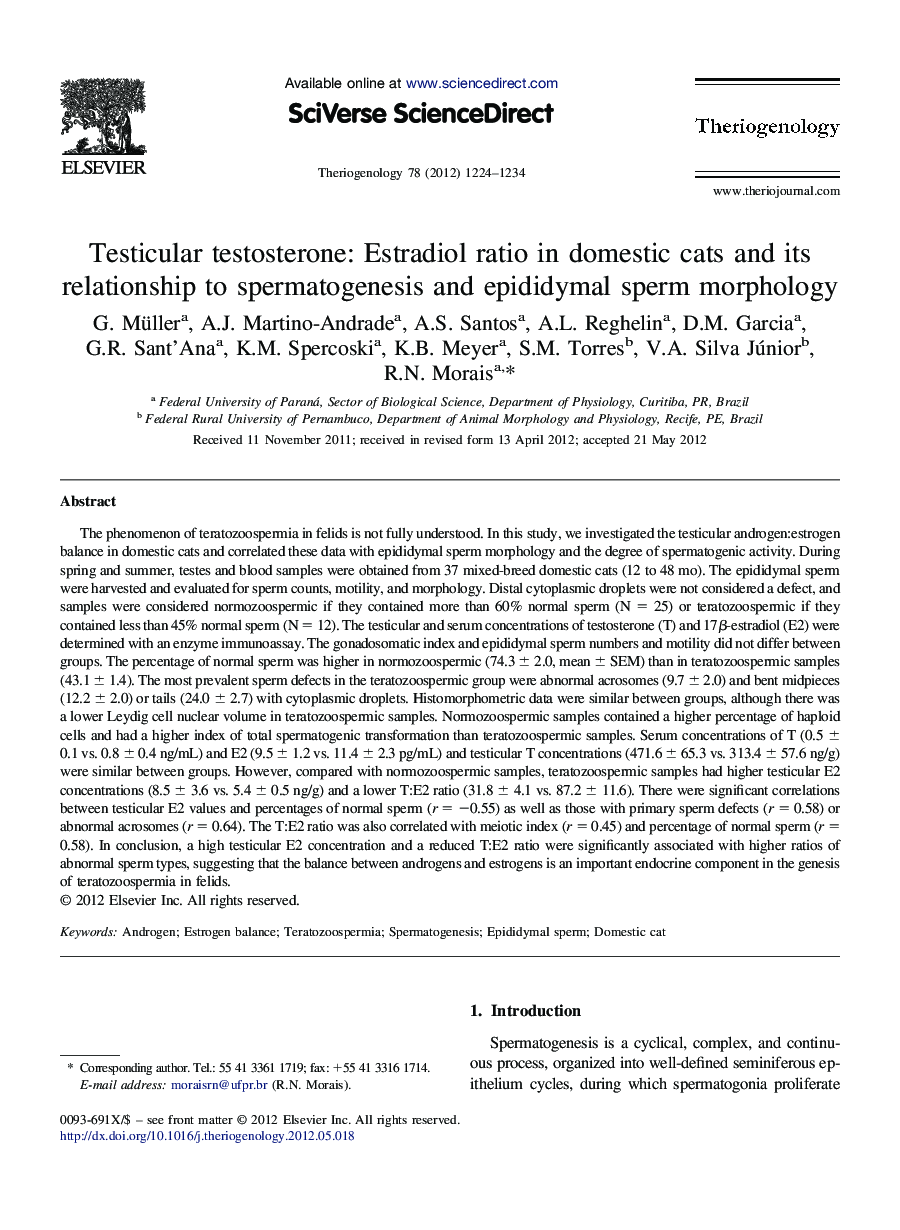| Article ID | Journal | Published Year | Pages | File Type |
|---|---|---|---|---|
| 10892363 | Theriogenology | 2012 | 11 Pages |
Abstract
The phenomenon of teratozoospermia in felids is not fully understood. In this study, we investigated the testicular androgen:estrogen balance in domestic cats and correlated these data with epididymal sperm morphology and the degree of spermatogenic activity. During spring and summer, testes and blood samples were obtained from 37 mixed-breed domestic cats (12 to 48 mo). The epididymal sperm were harvested and evaluated for sperm counts, motility, and morphology. Distal cytoplasmic droplets were not considered a defect, and samples were considered normozoospermic if they contained more than 60% normal sperm (N = 25) or teratozoospermic if they contained less than 45% normal sperm (N = 12). The testicular and serum concentrations of testosterone (T) and 17β-estradiol (E2) were determined with an enzyme immunoassay. The gonadosomatic index and epididymal sperm numbers and motility did not differ between groups. The percentage of normal sperm was higher in normozoospermic (74.3 ± 2.0, mean ± SEM) than in teratozoospermic samples (43.1 ± 1.4). The most prevalent sperm defects in the teratozoospermic group were abnormal acrosomes (9.7 ± 2.0) and bent midpieces (12.2 ± 2.0) or tails (24.0 ± 2.7) with cytoplasmic droplets. Histomorphometric data were similar between groups, although there was a lower Leydig cell nuclear volume in teratozoospermic samples. Normozoospermic samples contained a higher percentage of haploid cells and had a higher index of total spermatogenic transformation than teratozoospermic samples. Serum concentrations of T (0.5 ± 0.1 vs. 0.8 ± 0.4 ng/mL) and E2 (9.5 ± 1.2 vs. 11.4 ± 2.3 pg/mL) and testicular T concentrations (471.6 ± 65.3 vs. 313.4 ± 57.6 ng/g) were similar between groups. However, compared with normozoospermic samples, teratozoospermic samples had higher testicular E2 concentrations (8.5 ± 3.6 vs. 5.4 ± 0.5 ng/g) and a lower T:E2 ratio (31.8 ± 4.1 vs. 87.2 ± 11.6). There were significant correlations between testicular E2 values and percentages of normal sperm (r = â0.55) as well as those with primary sperm defects (r = 0.58) or abnormal acrosomes (r = 0.64). The T:E2 ratio was also correlated with meiotic index (r = 0.45) and percentage of normal sperm (r = 0.58). In conclusion, a high testicular E2 concentration and a reduced T:E2 ratio were significantly associated with higher ratios of abnormal sperm types, suggesting that the balance between androgens and estrogens is an important endocrine component in the genesis of teratozoospermia in felids.
Related Topics
Life Sciences
Agricultural and Biological Sciences
Animal Science and Zoology
Authors
G. Müller, A.J. Martino-Andrade, A.S. Santos, A.L. Reghelin, D.M. Garcia, G.R. Sant'Ana, K.M. Spercoski, K.B. Meyer, S.M. Torres, V.A. Silva Júnior, R.N. Morais,
